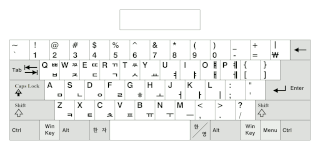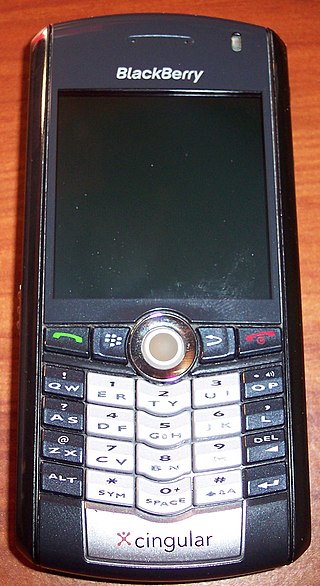Related Research Articles

A telephone, colloquially referred to as a phone, is a telecommunications device that enables two or more users to conduct a conversation when they are too far apart to be easily heard directly. A telephone converts sound, typically and most efficiently the human voice, into electronic signals that are transmitted via cables and other communication channels to another telephone which reproduces the sound to the receiving user. The term is derived from Ancient Greek: τῆλε, romanized: tēle, lit. 'far' and φωνή, together meaning distant voice.

An input method is an operating system component or program that enables users to generate characters not natively available on their input devices by using sequences of characters that are available to them. Using an input method is usually necessary for languages that have more graphemes than there are keys on the keyboard.
Tegic Communications, Inc. was a predictive text company based in Seattle, Washington, United States, founded on November 18, 1996. It was acquired by AOL on December 3, 1999, and subsequently, on August 24, 2007, acquired by Nuance Communications, whereafter it ceased to exist as a separate company.
Predictive text is an input technology used where one key or button represents many letters, such as on the physical numeric keypads of mobile phones and in accessibility technologies. Each key press results in a prediction rather than repeatedly sequencing through the same group of "letters" it represents, in the same, invariable order. Predictive text could allow for an entire word to be input by single keypress. Predictive text makes efficient use of fewer device keys to input writing into a text message, an e-mail, an address book, a calendar, and the like.
The Siemens S40 is a mobile phone. Originally developed as the Bosch 1886 in 2000, the phone was branded as the Siemens S40 after Siemens acquired the Bosch mobile phone division. The Siemens S40 is a tri-band mobile phone that operates on the GSM-900, GSM-1800, and GSM-1900 networks. Communication with a computer can be done either through the infrared port (IrDA) on the phone or a USB or serial port data cable. Its more distinctive features include the voice memo recorder, the mute feature for conversations, the ability to record phone conversations, and the ringtone composer.
ShapeWriter was a keyboard text input method for tablet, handheld PCs, and mobile phones invented by Shumin Zhai and Per Ola Kristensson at IBM Almaden Research Center and the Department of Computer and Information Science at Linköping University.

T9 is a predictive text technology for mobile phones, originally developed by Tegic Communications, now part of Nuance Communications. T9 stands for Text on 9 keys.

iTap is a predictive text technology developed for mobile phones, developed by Motorola employees as a competitor to T9. It was designed as a replacement for the old letter mappings on phones to help with word entry. This makes some of the modern mobile phones features like text messaging and note-taking easier.

A virtual keyboard is a software component that allows the input of characters without the need for physical keys. Interaction with a virtual keyboard happens mostly via a touchscreen interface, but can also take place in a different form when in virtual or augmented reality.

Martin Cooper is an American engineer. He is a pioneer in the wireless communications industry, especially in radio spectrum management, with eleven patents in the field.

LetterWise and WordWise were predictive text entry systems developed by Eatoni Ergonomics (Eatoni) for handheld devices with ambiguous keyboards / keypads, typically non-smart traditional cellphones and portable devices with keypads. All patents covering those systems have expired. LetterWise used a prefix based predictive disambiguation method and can be demonstrated to have some advantages over the non-predictive Multi-tap technique that was in widespread use at the time that system was developed. WordWise was not a dictionary-based predictive system, but rather an extension of the LetterWise system to predict whole words from their linguistic components. It was designed to compete with dictionary-based predictive systems such as T9 and iTap which were commonly used with mobile phones with 12-key telephone keypads.

The Katana, or Sanyo SCP-6600, was a type of mobile phone. It was released in the United States in the third quarter of 2006 by Sanyo Electric Co. The Katana was a clamshell style phone. The Katana was an "ultraslim" mobile phone with a design similar to the Motorola Razr V3.

The SGH-F700, marketed as the Ultra Smart F700, is a smartphone manufactured by Samsung. Using Vodafone as its network provider, the phone was first introduced at the 3GSM World Congress that was held in February 2007. Sales to the European market started November 2007.
Swype was a virtual keyboard for touchscreen smartphones and tablets originally developed by Swype Inc., founded in 2002, where the user enters words by sliding a finger or stylus from the first letter of a word to its last letter, lifting only between words. It uses error-correction algorithms and a language model to guess the intended word. It also includes a predictive text system, handwriting and speech recognition support. Swype was first commercially available on the Samsung Omnia II running Windows Mobile, and was originally pre-loaded on specific devices.

The Samsung SGH-E250i mobile was introduced in 2008 as a dual band variant version of the tri band Samsung SGH-E250.
XT9 is a text predicting and correcting system for mobile devices with full keyboards rather than the 3x4 keypad on old phones. It was originally developed by Tegic Communications, now part of Nuance Communications. It was originally created for devices with styluses, but is now commonly used for touch screen devices. It is a successor to T9, a popular predictive text algorithm for mobile phones with only numeric pads. A small XT9 label on can be seen certain phones, mainly on HTC phones.

Martin (Towle) King was an inventor and entrepreneur based in Seattle, WA, United States.

SureType is a QWERTY-based character input method for cell phones which is used on the BlackBerry Pearl. SureType combines a traditional telephone keypad with a QWERTY-based keyboard to create a non-standard way to input text on a cell phone. In addition, SureType contains a list of 35,000 English words, so when a user types the beginning of a word, all the possible words which start with those letters show up on the screen. Additional words can also be added to the word list.

MessagEase is an input method and virtual keyboard for touchscreen devices. It relies on a new entry system designed by Saied B. Nesbat, formatted as a 3x3 matrix keypad where users may press or swipe up, down, left, right, or diagonally to access all keys and symbols. It is a keyboard that was designed for devices like cell phones, mimicking the early cell phones' limited number of 12 keys.
Zi Corporation was a software company based in Calgary, Canada. The company was founded on 4 December 1987 as Cancom Ventures Inc, owning an Edmonton secretarial college and an industrial equipment rental business. On 30 August 1989 the name was changed to Multi-Corp Inc. In 1993, board member Michael Lobsinger took control of the company, became CEO, and turned the company towards the telecommunications industry, purchasing several privately held companies involved in the telecommunications businesses, and in November 1993, Multi-Corp entered into an exclusive licensing agreement with Eric Chappell for a stroke-based Chinese text entry system which they referred to as the Jiejing Licenses. A wholly owned subsidiary, Ziran Developments Inc, was formed to handle the Chinese text entry business.
References
- 1 2 Milian, Mark (2011-01-05). "The man who reinvented the keyboard – twice". CNN . Retrieved 2011-01-06.
- ↑ Engleman, Eric (2007-07-15). "Startup's aim: Scan a printed page, get a website". Puget Sound Business Journal . Retrieved 2011-01-06.
- ↑ "Regional News: 'Finger Texting' for Mobile Phone Users". Business. Seattle Post-Intelligencer . 2008-09-10. p. E2.
- ↑ "BusinessWeek Executive Profile".